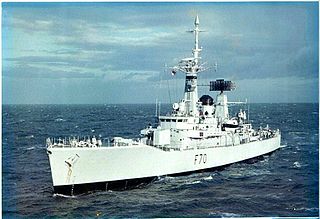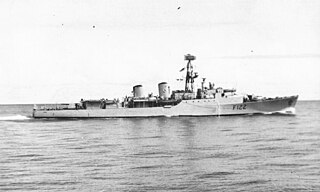
HMS Devonshire was the first of the County-class destroyers and the first Batch 1 ship of the Royal Navy. The ship was built by Cammell Laird in Birkenhead near Liverpool. With a displacement of 6,200 tons full load, Devonshire was named after the English county of Devon. She was launched on 10 June 1960 and delivered to the navy two years later.

HMS Fife was the first unit of the Batch 2 County-class destroyers of the Royal Navy. She was subsequently sold to Chile and scrapped in 2005.

HMS Andromeda was a Leander-class frigate of the Royal Navy. She was built at HM Dockyard Portsmouth. She was launched on 24 May 1967 and commissioned into the Royal Navy on 2 December 1968. She took part in the Falklands War. She was sold to India in 1995, for use as a training ship, being renamed INS Krishna. She was finally decommissioned in May 2012.

HMS Galatea (F18) was a Leander-class frigate of the Royal Navy. She was built by Swan Hunter & Wigham on the Tyne. She was launched on 23 May 1963 and commissioned on 25 April 1964 and was the eighth ship of the Royal Navy to bear the name.

HMS Naiad (F39) was a Leander-class frigate of the Royal Navy (RN). Like the rest of the class, Naiad was named after a figure or figure of mythology, in this case, the Naiads of Greek mythology. Naiad was built by Yarrow Shipbuilders of Scotstoun. She was launched on 4 November 1963 and commissioned on 15 March 1965.

HMS Arethusa was a Leander-class frigate of the Royal Navy. She was, like most of the Leanders, named after a figure of mythology. Arethusa was built by J.S. White & Company Shipbuilders of Cowes, launched on 5 November 1963 and commissioned on 24 November 1965.

HMS Apollo was a batch 3B broadbeam Leander-class frigate of the Royal Navy. She was, like the rest of the class, named after a figure of mythology. Apollo was built by Yarrow Shipbuilders of Scotstoun. She was launched on 15 October 1970 and commissioned on 28 May 1972, making her the penultimate Leander.
HMS Phoebe (F42) was a Leander-class frigate of the Royal Navy (RN). She was, like the rest of her class, named after a figure of mythology. Built by Alexander Stephen and Sons on the River Clyde, she was launched on 19 December 1964 and commissioned on 15 May 1966.

HMS Gurkha (F122) was a Tribal-class frigate of the Royal Navy. She was named after an ethnic group located in Nepal, and who continue to serve in the British Army. She was sold to the Indonesian Navy in 1984 and renamed KRI Wilhelmus Zakarias Yohannes (332).

HMS Nubian was a Tribal-class frigate of the Royal Navy in service from 1962 and 1979. She was named after the Nubian ethnic group, located in Egypt and Sudan. She was sunk as a target in 1987.

HMS Grampus (S04) was a Porpoise-class submarine. Her keel was laid down in 1955 by Cammell Laird at Birkenhead. She was launched by Lady Shepheard on 30 May 1957. She was first commissioned on 19 December 1958.

HMS Hardy was an anti-submarine warfare frigate of the Blackwood class or Type 14. She was named after Thomas Masterman Hardy, Captain of HMS Victory at Trafalgar. Hardy was the first Type 14 frigate built, completed on 8 December 1955, by Yarrow Shipbuilders.

HMS Dundas was a Blackwood-class anti-submarine warfare frigate of the Royal Navy.

BAPFerré(DM-74) was a Daring-class destroyer in service with the Peruvian Navy from 1973 to 2007. She was built by Yarrow Shipbuilders and completed for the Royal Navy in 1953 as HMS Decoy (D106).

HMS Otus was a Royal Navy Oberon-class submarine launched in 1962. She was decommissioned in the early 1990s and is now a naval museum in Germany.

HMS Rothesay was the lead ship of the Rothesay or Type 12M class of anti-submarine frigates of the British Royal Navy. She was commissioned in 1960 and scrapped in 1988.

HMS Wakeful was a W-class destroyer of the Royal Navy launched in 1943. She saw service during the Second World War and was later converted into a Type 15 fast anti-submarine frigate. She was sold for scrap in 1971.

HMS Oracle was an Oberon-class submarine of the Royal Navy.

HMS Token was a British submarine of the third group of the T class. She was built as P328 at Portsmouth Dockyard, and launched on 19 March 1943. So far she has been the only ship of the Royal Navy to bear the name Token.

HMS Talent was a British submarine of the third group of the T class. She was built as P337(S37) by Vickers Armstrong, Barrow, and launched on 13 February 1945. She was originally to have been named HMS Tasman, but was this was changed to Talent after the previous HMS Talent was transferred to the Royal Netherlands Navy, this may have also been the case due to confusion with HMNZS Tasman in Lyttelton, New Zealand.



















